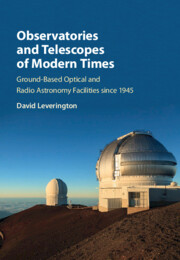 Observatories and Telescopes of Modern Times
Observatories and Telescopes of Modern Times from Part 2 - Radio Observatories
Published online by Cambridge University Press: 15 December 2016
The Soviet Union
The possibility of using radio to determine the distance of the Moon from Earth had been seriously considered by the Soviet radio physicists Leonid Mandel'shtam and Nikolai Papaleski as long ago as 1925, before accepting that it was not possible with the equipment available at that time.(1) However in 1943 they revisited the situation and concluded that radar observations of the Moon were then feasible. But researchers in the USA and Hungary were the first to succeed in making them three years later.
Papaleski had also considered the possibility of carrying out radar observations of the Sun and around the end of 1945 he asked Vitaly Ginzburg, of the P. N. Lebedev Physical Institute (LPI), to theoretically analyse the reflection of radio waves by the Sun. In the following year Ginzburg concluded from his subsequent analysis that radio waves from Earth would not reach the Sun's photosphere as they would be absorbed by either its chromosphere or corona.(2) Simultaneously and independently Iosif Shklovskii, of the Sternberg Astronomical Institute of Moscow State University, showed that solar thermal radiation in the metre waveband, discovered by the British army during the war, could not be emitted by the solar photosphere or chromosphere but must be emitted by the solar corona.(3) Also independently, in Australia David Martyn concluded in the same year that the solar emission measured by Joe Pawsey in the metre waveband must be coming from high in the solar corona as the corona would be opaque at those wavelengths, so it could not be coming from lower down in the solar atmosphere (see Section 16.1). These theoretical conclusions of Ginzburg, Shklovskii and Martyn were proved to be correct in the following year by a Soviet expedition led by A. A. Mikhailov and Semion Khaikin to observe a total solar eclipse in Brazil. The expedition found that the intensity of radio emission at a wavelength of 1.5 m (frequency 200 MHz) was, at totality, still about 30% of its level out of eclipse.
On his return Khaikin submitted a proposal to study radio wave propagation in the Earth's atmosphere using extraterrestrial sources, such as the Sun, Moon and other discrete radio sources covering the wavelength range from 3 m to 3 cm. This information was required by the military for the radio navigation of rockets,(4) and consequently the proposal was rapidly approved.
To save this book to your Kindle, first ensure [email protected] is added to your Approved Personal Document E-mail List under your Personal Document Settings on the Manage Your Content and Devices page of your Amazon account. Then enter the ‘name’ part of your Kindle email address below. Find out more about saving to your Kindle.
Note you can select to save to either the @free.kindle.com or @kindle.com variations. ‘@free.kindle.com’ emails are free but can only be saved to your device when it is connected to wi-fi. ‘@kindle.com’ emails can be delivered even when you are not connected to wi-fi, but note that service fees apply.
Find out more about the Kindle Personal Document Service.
To save content items to your account, please confirm that you agree to abide by our usage policies. If this is the first time you use this feature, you will be asked to authorise Cambridge Core to connect with your account. Find out more about saving content to Dropbox.
To save content items to your account, please confirm that you agree to abide by our usage policies. If this is the first time you use this feature, you will be asked to authorise Cambridge Core to connect with your account. Find out more about saving content to Google Drive.